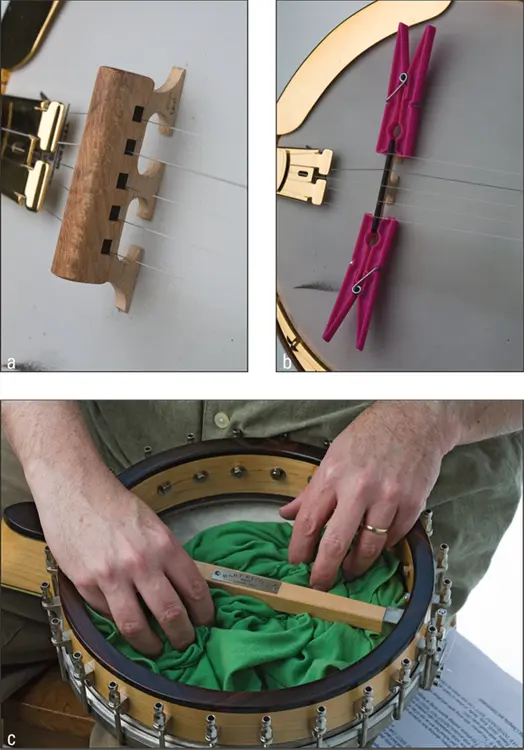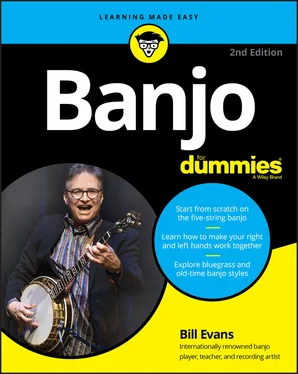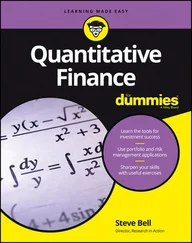PROMOTE WORLD PEACE: USE A BANJO MUTE!
If you're one of those folks who lives in a crowded household or a college dorm, or if you have to catch your practice time late at night or very early in the morning, you need to find a way to ramp down the volume of your banjo. Try these quick solutions to temporarily tame your savage banjo beast:
Place a mute on the bridge. A banjo mute fits onto the top of your banjo bridge and soaks up the musical energy that the bridge normally transmits from a vibrating string to the banjo head. (See photo a in the accompanying figure.) Mutes dramatically reduce your banjo's volume and can change the tone quite a bit too, lending a sweet sustaining sound to your banjo that makes it sound almost like a harpsichord. You can buy a banjo mute at an acoustic specialty store (but don't let them talk you into believing that a ball-peen hammer is a real mute — that's a more permanent solution!). In lieu of a store-bought mute, you can also use a couple of clothespins, snapped to either end of the bridge (as shown in photo b). This solution works just about as well!
Just stuff it! Cram a hand towel or a T-shirt into the back of the banjo, in the space between the head and the closest coordinating rod or the dowel stick (take a look at photo c). If your banjo has a resonator, you need to remove it first to get to the back of your instrument. The more firmly you position the cloth against the underside of the head, the more it absorbs the energy of the head and the quieter your banjo becomes.

Photographs by Anne Hamersky
Chapter 3
Starting to Play: Fretting and Strumming
IN THIS CHAPTER
 Understanding banjo terms
Understanding banjo terms
 Sitting and standing with the banjo
Sitting and standing with the banjo
 Using the left hand to fret chords
Using the left hand to fret chords
 Playing the G, D7, and C chords
Playing the G, D7, and C chords
 Understanding chord diagrams and chord progressions
Understanding chord diagrams and chord progressions
 Access the audio tracks and video clips at www.dummies.com/go/banjo
Access the audio tracks and video clips at www.dummies.com/go/banjo
You've brought your new banjo home and cleared a corner of the house to practice, far enough out of the way to avoid disturbing the unbelievers in your household. As you sit down and open the case, that wonderful new banjo smell fills the room, and you're no doubt thinking that this instrument is about the most beautiful thing you've ever seen in your entire life. Go ahead and savor this moment! Pat yourself on the back for taking the plunge and making the commitment to become a banjo player. But now what? Where do you begin? Now that you're a banjo owner, what are the first steps on the road to becoming an actual banjo player?
This chapter answers these questions. Get started by attaching a strap on your banjo so you can play both sitting and standing. Next, put your left hand to work, find a comfortable hand position, and then really get down to business positioning your fingers to fret the G, C, and D7 chords. Finally, combine fretting chords with some mighty right-hand strumming to play your first, honest-to-goodness song. You're going to be amazed at how quickly you can make great-sounding music.
Many folks prepare for a trip to a foreign country by practicing a few phrases in the language that's spoken there. Playing the banjo is very much the same kind of adventure — it's great to know banjo speak before you start to make banjo music. Plus, you may find Banjo For Dummies a little clearer if you know some of the basic terms I use throughout this book.
Although that banjo-playing kid in the Deliverance movie didn't talk very much, it's still helpful to familiarize yourself with the following basic banjo terms:
Left hand: When I give you any instructions regarding the left hand, I'm referring to the hand you use to push the strings against the fingerboard to make chords (you do this with the tips of your fingers, of course, not the entire hand). You also use the left-hand fingers to create new notes on the banjo by using slides, hammer-ons, pull-offs, and chokes (slide on over to Chapter 6to discover more about these special techniques). If you're a left-handed banjo player playing a banjo especially made for left-handed players, you make these same moves with your right hand.
Right hand: The right hand is the hand that strikes the banjo strings. In Banjo For Dummies, you first use the right-hand thumb to strum across all the banjo strings, but soon enough you utilize techniques where the right-hand thumb and the index and middle fingers each play a different role in producing authentic right-hand banjo styles (you can find these techniques in Chapter 5). If you're playing a left-handed banjo, you use your left hand to make these moves.
Frets: The raised metal strips that run along the top surface of your banjo fingerboard underneath and perpendicular to your strings are the frets. Most banjos have 22 frets with each fret assigned a number. The 1st fret is the fret that's closest to the nut and the 22nd fret is located the closest to the banjo head.
Fretting: The act of pushing one or more left-hand fingers against the fingerboard just behind a fret to shorten the length of a string is called fretting. Fretting changes the sound (or pitch ) of a note. The shorter the length of a string, the higher that string's pitch — and the higher up the neck you're fretting. (For more on fretting, you can check out the section “ Fretting with the Left Hand” later in this chapter.)
Open: You call an unfretted string an open string. Later in this chapter, you're introduced to tablature, the written form of banjo music. In tablature, an open string is indicated with the number 0.LEFT-HANDED BUT NOT LEFT OUT!If you're left-handed, playing the banjo creates a unique challenge. Unlike a guitar or mandolin, you can't just flip the banjo around and switch hands to play because the shorter 5th string tuning peg will no longer be positioned as it should be on the top of the banjo neck. If you already own a right-handed banjo, try playing it in the right-handed way for a couple of weeks and see how it goes. On the other hand, if you don't yet own a banjo or if you're experiencing a great deal of frustration trying to play in that strange right-handed way, pay a visit to your nearest full-service acoustic instrument store and try out a left-handed instrument. I guarantee that after you try both kinds of banjos, you will know very quickly which kind will be best for you.Full disclosure: I'm left-handed but I learned to play right-handed. However, I've taught several left-handed students who wouldn't play any other way than with a left-handed instrument.
Strings: Yeah, I know you know what strings are. But banjo players are so methodical that they assign numbers to each string so they can talk about them more easily. Remembering the order of strings as expressed through these numbers is crucial to understanding banjo tablature and interpreting a chord diagram, which is a representation of how a chord is fretted.
Читать дальше


 Understanding banjo terms
Understanding banjo terms










